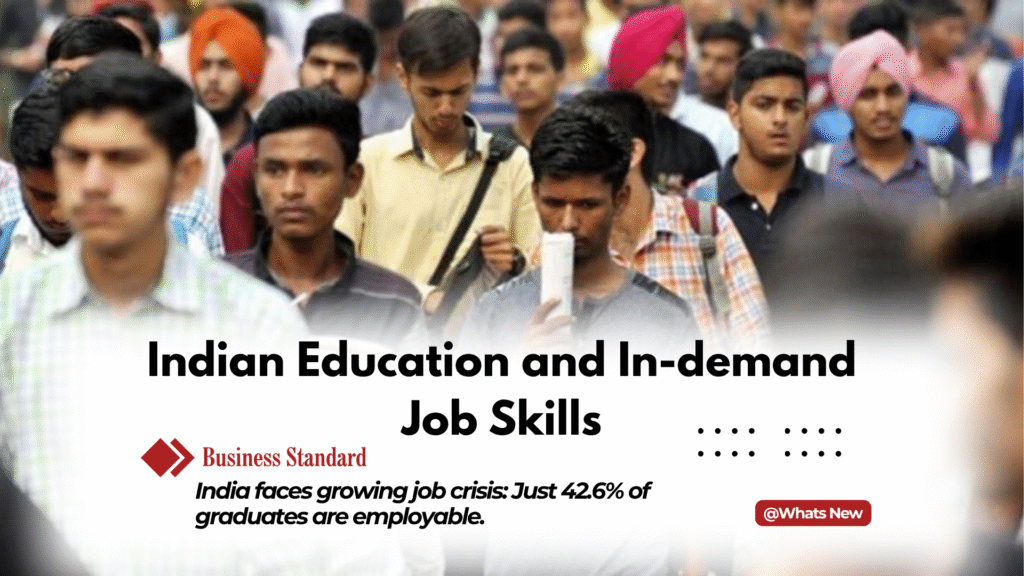
India’s job market is at a crossroads. Indian education and in-demand job skills are creating a critical gap. As industries evolve with artificial intelligence (AI) and automation, fresh graduates are struggling to keep up. A new report, India’s Graduate Skill Index 2025 by Mercer-Mettle, reveals that only 42.6 percent of Indian graduates are employable—marking a decline from 44.3 percent in 2023.
How the gap seen between Indian education and in-demand job skills.
The biggest challenge: a widening gap between what employers need and the skills graduates have. While technical skills like AI and data analytics are in high demand, non-technical abilities such as communication, problem-solving, and creativity are lagging behind. This has made it harder for many fresh graduates to secure jobs.
1. Youth Unemployment & Employability Trends
Youth Unemployment Rate (Ages 15–29)
| Year | Youth Unemployment Rate (%) |
| 2019 | ~17.8 % |
| 2022–23 | ~10.0 % |
| 2023–24 | ~10.2 % |
- Youth unemployment plummeted from 17.8% in 2017–18 to about 10% by 2022–23.
- Official data reports 10.2% in 2023–24.
- Meanwhile, overall unemployment (population ≥ 15 years) ranged between 4.1% and 4.2% during 2020–23.
Graduate Employability & Skilled Youth
- Only ~4–5% of youth are formally vocationally trained or certified in job‑relevant skills.
- Reports show that graduated employability—degree holders who are job-ready—is between 42–51%, depending on the study. One study cited 51% employability (Economic Survey), while others indicate 42–43%.
2.Why the Skills‑Jobs Gap Persists
a) Overproducing Degrees, Not Skills
Indian universities continue to graduate more students than there are industry‑aligned roles. A position paper estimates that only 300,000 new tech jobs are created per year, while engineering graduates number ~900,000 annually—leaving 500,000 graduates with no matching jobs.
b) Low Vocational & Practical Training
Formal vocational training remains low (~2–3 % of workforce until recently). Short‑term skilling courses (under 6 months) dominate—up from 22% in 2017–18 to 37% in 2022–23—yielding limited job placement results.
c) Mismatch in Skills Demand
Industries demand soft skills (communication, critical thinking, creativity), digital literacy (AI, data, coding), and domain-specific competencies—but education is often theory-heavy and misaligned.
d) Structural & Informal Sector Constraints
India’s structural transition favors services output but not formal job creation. Many workers shift from informal agriculture to informal services without wage security or skill alignment.
3. Skills That Matter for Employment
Technical & Digital Capabilities
- Data analytics, coding, AI/ML tools, basic automation skills are increasingly expected—especially in tech, finance, logistics, and retail sectors. Yet only a small share of the youth has engaged in such programs.
Vocational & Domain Skills
- Skilled trades (mechanical, ITI-based, hospitality, retail logistics, and retail services) taught via PMKVY and NSDM schemes are vital—but placement outcomes remain inconsistent.
Soft Skills & Critical Thinking
- Communication, teamwork, leadership, adaptability and creativity are essential. Many graduates score low on creativity and problem-solving despite scoring well on theoretical aspects.
Internship & Real‑World Exposure
- Hands-on experience via internships, apprenticeships, project-based learning, and industry-linked curriculums significantly boost employability.
4. Government Initiatives & Limitations
- Skill India Mission (2015) and PMKVY aim to scale vocational training nationally.
- Criticisms include low placement rates (~20%), short course durations, and limited employer collaboration.
Summary
Despite a decline in youth unemployment—from ~17.8% in 2017–18 to ~10% in 2022–23—it still exceeds the national average. This is due to a growing disconnect between formal degrees and job-relevant skills. Only around 4–5% of youth have formal vocational certifications, and just ~42–51% of graduates are deemed job-ready.
Report say In Indian Education and In-Demand Job Skills urgently needs to pivot from degree-based education to skill-aligned, hands-on, industry-integrated learning. Focusing on digital fluency, soft skills, domain-specific vocational training, and extended internship/apprenticeship programs are vital. Additionally, aligning educational institutions with regional industry needs and scaling placement-oriented skilling—while reducing mismatches—is essential to unlock the potential of India’s demographic dividend.
Recommendations for Youth and Institutions
- Youth should focus on certifications in coding, data science, AI tools, digital marketing, and vocational trades in demand.
- Colleges should embed internships, co-op programs, and practical projects in their curricula.
- Policy-makers should improve coordination between ministries, expand well‑structured vocational training, and incentivize employer‑led placement for skill initiatives.
